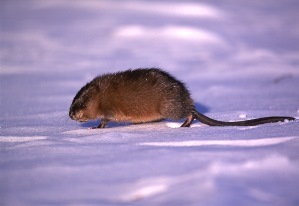Wetlands Month featured creature: the muskrat
 May is American Wetlands Month – a month to appreciate and enjoy the wonders of wetlands! Take some time to experience this amazing native ecosystem by visiting one of Michigan’s Wetland Wonders. There, you may find one of Michigan’s most fascinating aquatic mammals – the muskrat. May is American Wetlands Month – a month to appreciate and enjoy the wonders of wetlands! Take some time to experience this amazing native ecosystem by visiting one of Michigan’s Wetland Wonders. There, you may find one of Michigan’s most fascinating aquatic mammals – the muskrat.
Muskrats are a rich brown color and are roughly 18-25 inches long from the tip of their nose to the end of their hairless, round, brown tails. They weigh about 2-3 pounds and have partially webbed hind feet to help them swim in the marshes, lakes, ponds and slow-moving streams they inhabit.
Plants are the primary food source for muskrats, including the roots and stems of aquatic plants like cattails, arrowhead, waterlily and rushes. Muskrats will also sometimes eat meat, including fish, crayfish, mussels, turtles and frogs. Muskrats usually feed within 50 to 500 feet of their den.
Muskrats build dens, with one or more underwater entrances, in the sides of elevated banks along streams, lakes and ponds. In marshy areas, muskrats build their homes out of cattails. These cattail houses can be up to 6 feet in diameter and 4 feet high. The walls are up to an inch thick, and the interior of these cozy homes can be 35 degrees warmer than the outside air!
Young muskrats are born between March and October each year. Litters contain four to eight young, and females can have up to three litters each year. Because of this, local muskrat populations can increase quite quickly! Predators of muskrats include raccoons, mink, foxes, hawks, eagles and snapping turtles. Trappers take a number of muskrats each year for their fur and for food. Vehicle accidents are another common cause of mortality.
Muskrats, found at most of Michigan’s state game and wildlife areas, are very enjoyable to watch. Visit your local state game area, or check out a new one, this May, and keep your eye out for these interesting creatures.
Michigan’s state game and wildlife areas are free to wildlife watchers. Hunting license fees pay for habitat management at these areas. Even if you are not a hunter in the traditional sense, consider purchasing an $11 dollar base license to help the creatures you hunt with your binoculars, cameras and spotting scopes.
Also consider liking the Michigan Waterfowl Legacy (MWL) on Facebook! MWL is a 10-year, cooperative partnership to restore, conserve and celebrate Michigan's waterfowl, wetland and waterfowl hunting community. The initiative is a "call to action" to honor yesterday, engage today and build for tomorrow. To learn more, visit www.mi.gov/mwl or look for MWL on Facebook.
The Michigan Department of Natural Resources is committed to the conservation, protection, management, use and enjoyment of the state’s natural and cultural resources for current and future generations. For more information, go to www.michigan.gov/dnr.
|

 May is American Wetlands Month – a month to appreciate and enjoy the wonders of wetlands! Take some time to experience this amazing native ecosystem by visiting one of Michigan’s
May is American Wetlands Month – a month to appreciate and enjoy the wonders of wetlands! Take some time to experience this amazing native ecosystem by visiting one of Michigan’s 




